In this episode of Biographers in Conversation, the historian Dr Pamela D. Toler chats with Dr Gabriella Kelly-Davies about her choices while crafting The Dragon from Chicago. The Untold Story of an American Reporter in Nazi Germany. For fans of unheralded women’s stories, The Dragon from Chicago shares the electrifying story of Sigrid Schultz—one of the earliest reporters to warn Americans of the rising threat of the Nazi regime—a story that draws striking parallels to the rise of fascism today.
The greatest service we could render our country was to try to marshal the facts as they were and not as propagandists tried to make them appear.
Sigrid Schultz
The portrait of Schultz that emerges is dazzling!
Publishers Weekly
The Dragon from Chicago
The Dragon from Chicago is a gripping biography of Sigrid Schultz, the Chicago Tribune’s Berlin bureau chief and primary foreign correspondent for Central Europe from 1925 to January 1941. Sigrid Schultz witnessed Hitler’s rise to power and was one of the last foreign correspondents to leave Berlin before it was too late.
Sigrid interviewed Hitler, broke the story of the Nazi-Soviet pact, and reported firsthand from the death camps. In The Dragon from Chicago, Pamela Toler chronicles Sigrid’s investigative escapades and scoops, such as a 1939 visit with Hitler’s astrologer that allowed her to break the news of Germany’s nonaggression pact with the Soviet Union.
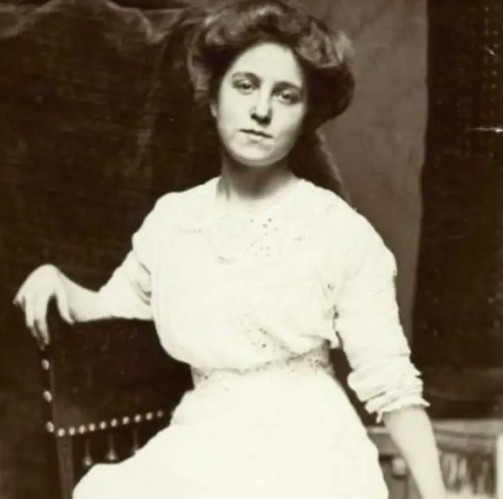
Sigrid Schultz, c1910.
Sigrid’s story mirrors the threats we face today with the alarming upsurge of misinformation and attempts by powerful figures to discredit facts so they can seize control of our political and cultural narratives.
Pamela Toler shares Sigrid’s years spent courageously reporting the news from Berlin, from the revolts of 1919 through the Nazi rise to power and Allied air raids over Berlin in 1941. At a time when female reporters rarely published front-page stories, Sigrid Schultz regularly reported the truth about Nazi Germany in the face of censorship and the threat of expulsion, internment or death.
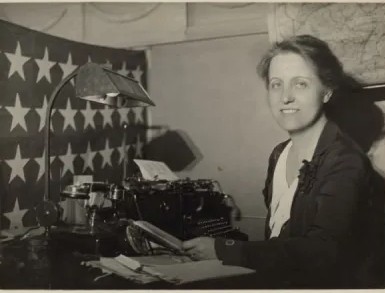
Sigrid Schultz at her typewriter at the Chicago Tribune Berlin Bureau.
The Nazis referred to Sigrid Schultz as ‘that dragon from Chicago’. One of her fellow correspondents called her ‘Adolph Hitler’s greatest enemy.’ Sigrid herself claimed to be ‘just a reporter’. Her story is a powerful account of one woman standing up for truth in an era marked by the spread of disinformation and propaganda spawned by hate.
Contextualising Sigrid Schultz’s experiences during the rise of Hitler and Nazism
The Dragon from Chicago reveals Sigrid’s fearlessness and determination to reveal the truth about what was really happening in Germany. An eyewitness to history, she shattered gender stereotypes and fought for the truth against lies and propaganda—a valuable lesson for our time as well as her own.
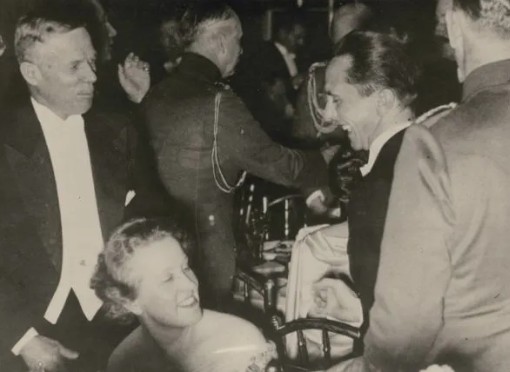
Sigrid Schultz, Ambassador William Dodd, and Nazi propaganda minister Joseph Goebbels
photographed together at the Foreign Press Ball.
One of the only journalists of her era to systemically analyse in her Chicago Tribune reporting how the Nazis manipulated the media, Sigrid’s journey is a testament to the power of ethical journalism and the importance of an unwavering dedication to the truth. Her ability to break crucial stories highlight her exceptional bravery and commitment. Sigrid’s journalism not only informed the world about the atrocities of the Nazi regime but also proved that women could excel in the male-dominated field of journalism.
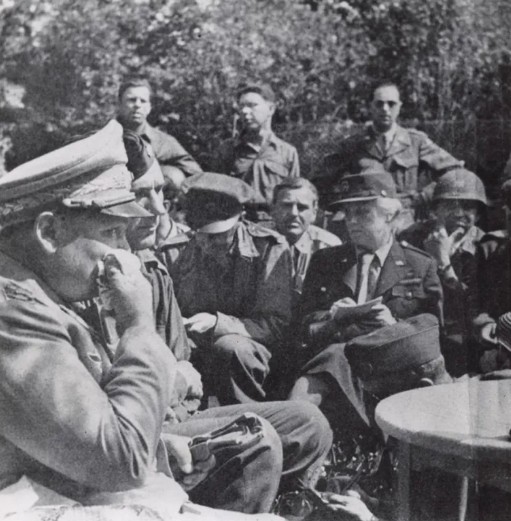
Sigrid seated front-and-centre at a group interview with Nazi leader Hermann Göring, days after his capture by the US Army.
By permission of Pamela Toler.
The Dragon from Chicago underscores the relevance of Sigrid’s story in today’s world of AI, social media and fake news. In an era where misinformation and propaganda are rampant, Sigrid’s legacy serves as a powerful reminder of the critical role ethical journalists play in holding those in power to account and ensuring the truth prevails. Her experiences offer valuable lessons on the crucial importance of integrity, courage and perseverance in the face of personal danger and adversity.
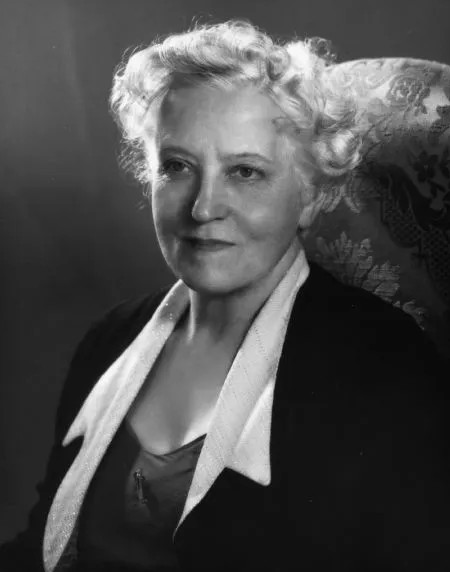
Sigrid Schultz, 1930.
Portrait photo by Charles Leon.
As we reflect on The Dragon from Chicago, it’s a biography of a remarkable woman and a call to action for current and future generations of journalists. It encourages us to continue the fight for truth and justice, no matter the obstacles.
Pamela Toler’s objective in crafting The Dragon from Chicago
Praise For The Dragon from Chicago
Foreign correspondent Sigrid Schultz (1893–1980), who reported from Berlin between 1919 and 1941, was one of the first and most vocal journalists to document the growing threat of Nazism, according to this exhilarating biography. Historian Toler (Women Warriors) shows that Schultz was the only journalist of her era to systematically analyse in her reporting (which regularly appeared in the Chicago Tribune) how the Nazis manipulated the media—both by misrepresenting facts to the German public and by bribing and threatening the foreign press.
Schultz, who was born in Chicago but raised in Europe, had ‘a European’s understanding of Europe,’ which she worked to her advantage, cultivating informants who faced incredible risk for communicating with her.
Toler’s propulsive narrative, which chronicles Schultz’s investigative escapades and scoops (like a 1939 visit with Hitler’s astrologers that allowed her to break the news of Germany’s nonaggression pact with the Soviet Union), is a journalistic adventure story of the highest calibre (it opens with a riveting scene of Schultz grilling Hermann Göring over press freedom; ‘You’ll never learn to show the proper respect for state authorities,’ he tells her. ‘I suppose that is one of the characteristics of people from that crime-ridden city of Chicago’).
The portrait of Schultz that emerges is dazzling (‘small, blond, and surprisingly formidable,’ she was, according to one fellow correspondent, ‘Hitler’s greatest enemy’).
This is stellar.
Publishers Weekly
In her riveting 10th nonfiction book, historian Pamela D. Toler (Women Warriors) profiles reporter Sigrid Schultz (1893-1980), who ran the Berlin bureau of the Chicago Tribune for a decade and a half, and repeatedly warned her American readers about the rise of Nazism.
Born in Chicago to a Norwegian painter and a mother of multiethnic European descent, Schultz always considered herself American, though she spent decades living abroad.
A multilingual, only child, she worked as a teacher and a translator as a young woman before meeting several journalists from the Tribune as World War I ended. She took a job as a ‘combination interpreter and cub reporter,’ using her broad network of connections in Berlin to gain the interviews her colleagues wanted. The job gave Schultz the training she needed to become a star journalist, and eventually to head up the Tribune’s Berlin bureau.
Toler’s narrative paints a fascinating picture of her subject: a woman driven to hunt down the next story and to bring the truth to her readers. Determined to prove herself equal to her male colleagues, Schultz worked long hours, carefully verified her facts, and called herself a ‘newspaperman.’
She reported on local and national politics, the growing military might of the Nazi Party, and the lives of ordinary Germans in Weimar-era Berlin, often throwing parties to cultivate connections for stories. Toler charts the rise of the Nazis through Schultz’s fastidious reporting on their activities and her clever ways of getting around the censors, including the use of a male pseudonym.
Due to illness and exhaustion, Schultz left Berlin for a planned vacation in January 1941. She ended up spending the rest of the war in the U.S., safe from Nazi violence but longing to return to her reporting work. She did return to report on the postwar trials at Lüneburg, helping to expose the horrors of the concentration camps.
Toler chronicles Schultz’s struggle to carve out a new place for herself once the war ended. She tried her hand at lecture tours, magazine articles, and book writing, though she admitted she was ‘just a reporter’ in the end. Toler exposes the discrimination Schultz often faced as a woman in male-dominated press offices but also highlights her successes: her broad network of informants, her sharply reported articles, and her invaluable contributions to the Tribune.
Vivid, insightful, and meticulously researched, Toler’s biography turns a well-deserved spotlight on Schultz and her career.
Katie Noah Gibson
Shelf Awareness
A biography of Sigrid Schultz (1893-1980), who reported from Germany from the 1920s to the end of World War II. Toler, a translator and author of Heroines of Mercy Street, provides an adept, engaging portrait of her subject. Schultz was born in Chicago, the daughter of a Norwegian painter and his German-born wife. Brought up in a cosmopolitan community, she was fluent in French and German by the time her family moved to Europe in 1901.
After a spell in Germany, where her father had several commissions, they settled in Paris. She travelled widely, attended classes at the Sorbonne, and added Norwegian and Italian to her stock of languages. In 1913, the family moved to Berlin. When World War I broke out, her father’s commissions dried up and she taught English and French to wealthy families to pay the bills.
Then, in 1919, Chicago Tribune reporter Dick Little offered her a job as interpreter and cub reporter in the paper’s Berlin office. Schultz accompanied him to interviews, connecting with important people who became valuable sources when she began writing her own stories. She proved adept at dodging the gatekeepers—and later, the Nazi censors—to get the facts.
In 1926, she was appointed chief of the Tribune’s Berlin office, a position from which she reported on the rise of Hitler. By 1941, the growing war forced her to return to Chicago. After D-Day, she became a war correspondent for McCall’s Magazine and was among the first reporters to see the concentration camps following liberation.
After the war, she tried finding other writing work but never recovered her early success—partly because of poor health. Still, as Toler makes amply clear, she left a brilliant firsthand account of a dramatic era in 20th-century history.
A fascinating portrait of a trailblazing reporter who was an eyewitness to history.
Kirkus Reviews
Pamela D Toler knows she has a great subject, and like a canny biographer she stands back and lets Sigrid Schultz do her stuff…It is to Toler’s credit that she does not try to second-guess her subject, or to imagine what Schultz’s feelings ‘must have been.’ Schultz is the kind of subject for a biographer who knows her job is to report what her subject did and, when possible, explain why and show how she did it.
Schultz was no self-promoter and preferred the role of reporter more than anything else. We are fortunate that she has merited a biographer who does the same.’
Carl Rollyson
New York Sun
As the Chicago Tribune’s bureau chief in Berlin, Sigrid Schultz interviewed Hitler, broke the story of the Nazi-Soviet pact, and reported firsthand from the death camps. She deserves to be far better known than she is, and in The Dragon from Chicago, Pamela Toler admirably rescues her legacy. Intelligent, perceptive, and thoughtfully written, this is the definitive work on a foreign correspondent who shattered gender stereotypes and fought for the truth against lies and propaganda—a valuable lesson for our time as well as her own.’
Matthew Goodman, author of Eighty Days: Nellie Bly and Elizabeth Bisland’s History-Making Race Around the World
With documents and historical context presented in crisp, inviting prose, Pamela Toler has re-notched the place of Sigrid Schultz in that intriguing band of American correspondents of the 1920s to the 1940s—both men and women—who worked at the forefront of international reporting and news analysis.’
Brooke Kroeger, author of Undaunted: How Women Changed American Journalism
A wildly inspirational tale. I’m so glad that Toler rescued Schultz’s legacy.
Julia Scheeres, coauthor of Listen, World! How the Intrepid Elsie Robinson Became America’s Most-Read Woman
The Dragon from Chicago is not another story you’ve read before. It does what many good biographies do: it provides an intimate individual view of historic events that illuminates the better-known versions with new light. The story of multi-lingual European-raised Chicago Tribune journalist Sigrid Schultz is a riveting first-hand account, full of wild anecdotes, and resonance with our times.
Sara Catterall, author of Amelia Bloomer: Journalist, Suffragist, Anti-Fashion Icon
The Dragon from Chicago Media Coverage, Interviews, Talks and Podcasts
The What’s Her Name Podcast. The Warrior: Zenobia.
Author’s Voice
Smarty Pants Podcast
Open Stacks Podcast
Beacon Broadside: Bad-asses Through History - Women Warriors Have Always Fought
Talking About Writing with Pamela Toler, Author of Women Warriors
Book Q & As with Deborah Kalb.
The Dead Prussian Podcast: On Women Warriors
The Brain Magic Podcast
National Geographic: Nine Women Warriors Through History
Washington Post. Made by History. The First Time the U.S. Considered Drafting Women--75 Years Ago
Bustle.com. Eleven Overlooked Women from History, According to Ten Female Historians
Beacon Broadside: Bad-asses Through History - Women Warriors Have Always Fought
History Camp Author Discussions
Unsung History podcast
Herstory on the Rocks
History Camp Boston 2024
History Happy Hour
Lost Ladies of Lit podcast
What's Her Name podcast
The Remedial Herstory Project
Q & A with Peter Slen, on C-SPAN
Biographer’s International podcast
Book Cougars podcast
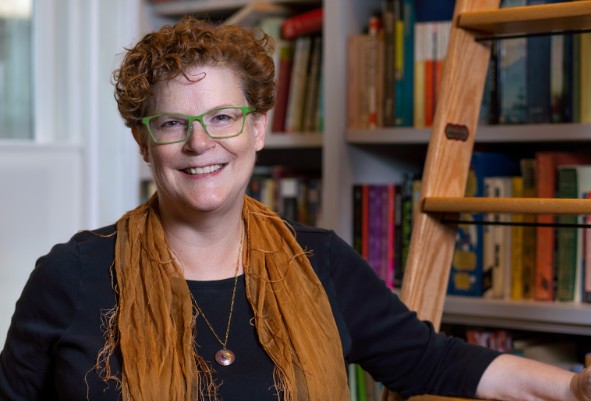
Armed with a PhD in history, a well-thumbed deck of library cards, and a large bump of curiosity, author, speaker, and historian Dr Pamela D. Toler translates history for a popular audience. She goes beyond the familiar boundaries of American history to tell stories from other parts of the world as well as history from the other side of the battlefield, the gender line, or the colour bar.
Toler is the author of ten books of popular history for children and adults, including Heroines of Mercy Street: Real Nurses of the Civil War, Women Warriors: An Unexpected History, and The Dragon From Chicago: The Untold Story of an American Reporter in Nazi Germany, due out in August, 2024. Her work has appeared in American Scholar, Aramco World, Calliope, History Channel Magazine, MHQ: The Quarterly Journal of Military History, Ms., Time.com and The Washington Post and has been featured in National Geographic.
The Story Behind The Dragon from Chicago by Pamela Toler
‘Like many history buffs, history first caught my imagination through stories.
One of my Favorite things to do when I was a child was to curl up next to my grandmother and ask her, ‘What did you do when you were a little girl?’ From there it was a short step to reading biographies about historical women who ignored social boundaries and accomplished things—the kind that are written with the intention of inspiring young girls. My grade school’s revolving library owned a whole series of them. Every week a new one arrived, and I snatched it before anyone else could get it, eager to read about Clara Barton, Madame Curie or Julia Ward Howe.
By the time I was in high school, I was that nerdy kid who hung out at the local historical society and at Wilson Creek National Battlefield on the weekends and in the summer. (I even learned to shoot a muzzle-loading rifle—a skill I never expected to be useful on my resume.)
My life as a history buff took an unexpected turn when at the age of eight or nine, I fell in love with Rudyard Kipling’s Kim. (Did I mention the importance of stories?) Kipling’s India put me on the path to a PhD in South Asia history.
It wasn’t a straight path. And it wasn’t a short one. The first day of my PhD program at University of Chicago, my advisor said, ‘You know there are no jobs, right?’ I knew, but I didn’t care. Without the promise (or perhaps the threat) of a teaching job at the end of the road, I kept wandering down fascinating by-ways. I still do, every chance I get.
Today my goal is to write books about important historical topics that will engage history buffs and nerdy kids and the intelligent general reader. (That’s you, right?)
Accessible doesn’t mean easy. The history I write often turns what we think we know about history inside out or at least looks at the familiar from an unfamiliar angle. In doing so, I ask the reader, and myself, to look at the world today from a slightly different angle as well. The impact of this can be profound.
If you are able to look at history from someone else’s perspective for even a short time, you are more apt to see her as a person rather than ‘the other.’ When we re-introduce overlooked populations into the story, we discover that our history is bigger and more complex than we realised.
On the other hand, sometimes I just want to tell a good story. Pull up a chair.
Pamela Toler’s Inspiration for Crafting The Dragon from Chicago
Dear Reader,
In March 2019, a story popped into my news feed: an architectural salvage vendor had discovered seventy-five glass plate photographic negatives in the attic of an old Chicago house. The images dated from the end of the nineteenth century. Most of them were informal pictures of a woman, a child, and a large dog, taken in and around the house itself with a camera normally used for formal studio portraits—not the kind of camera you would use to document daily life.
It was an intriguing historical puzzle to enjoy with my morning tea, so I read on. The little girl in the pictures was named Sigrid Schultz. The pictures were taken by Sigrid’s father—a successful portrait painter who had emigrated from Norway in 1892. Then I hit the punch line: Sigrid grew up to be a groundbreaking foreign correspondent and perhaps the first woman to be a foreign bureau chief for a major newspaper. I was hooked!
At the time, I was deep in the process of writing a proposal for a totally different book about another woman whose story deserves to be told. Sigrid elbowed her neatly off my desk. Her story was just too timely to ignore: She worked her way around glass ceilings. She kept the news flowing despite tightening controls on the media. She outwitted Nazis in Germany and stood up against pro-Nazi sympathizers at home. And she dealt with “fake news” on both sides of the Atlantic.
Over the last four years, I watched the rise of Nazi Germany through Sigrid’s eyes, and wondered if I would have been as courageous as she was. I hope I never have to find out. But if the time comes, I’ll ask ‘What would Sigrid do?’
Yours in history,
Pamela Toler
To Learn More About Pamela Toler, You’ll Find Her Here:
Website: https://www.pameladtoler.com/
Blog: https://www.historyinthemargins.com/
Bluesky: @pdtoler.bsky.social
Threads: pamelatolerauthor
Instagram: pamelatolerauthor
LinkedIn: Pamela Toler




